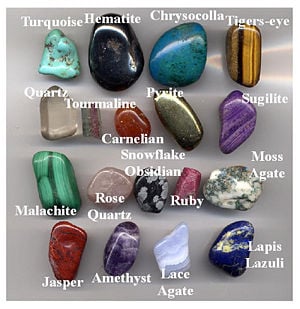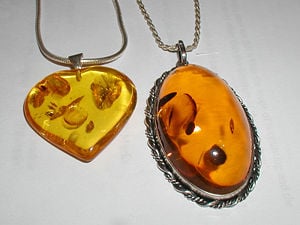Gemstone
- This article is about gemstones as jewelry or decorative art. For other uses of the word see gemstone (disambiguation).
A gemstone is a mineral, rock, or petrified organic matter that, when cut or faceted and polished, is collectible or can be used in jewelry. Some gemstones, such as single-crystal rhodochrosite, are beautiful and considered precious but are too soft or fragile to be used in jewelry. These stones are often exhibited in museums and sought by collectors.
- Others are organic, such as amber, which is fossilised tree resin and jet, a form of coal.
Characteristics and classification
Gemstones are made of various materials. For instance, diamonds are made of carbon (C), rubies of aluminum oxide (Al2O3, or corundum). Also, many gems are crystals, with structures such as cubic, trigonal, or monoclinic. Gemologists classify gemstones according to their chemical composition and crystal structure. Another term used by gemologists is "crystal habit," which is the form the gem is usually found in. For example, diamonds, which have a cubic crystal system, are often found as octahedrons.
Gems are classified into different groups, species, and varieties. For example, ruby is the red variety of the species corundum that belongs to the spinel or hematite group. Emerald (green), aquamarine (blue), bixbite (red), goshenite (colorless), heliodor (yellow), and morganite (pink) are all varieties of the mineral species beryl.
Properties of gems include their refractive index, dispersion of light, specific gravity (density), hardness, cleavage, fracture, luster, luminescence, and an absorption spectrum (spectrum of light absorbed by the material). If a gemstone contains other material or flaws, they are known as inclusions.
Value
A gemstone is prized especially for great beauty or perfection so appearance is almost the most important attribute of gemstones. Characteristics that make a stone beautiful or desirable are colour, unusual optical phenomena within the stone, an interesting inclusion such as a fossil, rarity, and sometimes the form of the natural crystal. Diamond is prized highly as a gemstone since it is the hardest naturally occurring substance known and is able to reflect light with fire and sparkle when faceted. However, diamonds are far from rare with millions of carats mined each year.
Traditionally, common gemstones were classified into precious stones (cardinal gems) and semi-precious stones. The former category was largely determined by a history of ecclesiastical, devotional or ceremonial use and rarity. Only five types of gemstones were considered precious: diamond, ruby, sapphire, emerald, and amethyst. In current usage by gemologists, all gems are considered precious, although four of the five original "cardinal gems" are usually—but not always—the most valuable.
Rare or unusual gemstones, generally meant to include those gemstones which occur so infrequently in gem quality that they are scarcely known except to connoisseurs, include andalusite, axinite, cassiterite, clinohumite and iolite.
Factors Influencing Esteem
Factors influencing the esteem in which gems are held are attractiveness, durability, rarity, fashion, and size.
Synthetic and artificial gemstones
Some gemstones are manufactured to imitate other gemstones. For example, cubic zirconia is a synthetic diamond simulant composed of zirconium oxide. The imitations copy the look and colour of the real stone but possess neither their chemical nor physical characteristics. However, true synthetic gemstones are not necessarily imitation. For example, diamonds, ruby, sapphires and emeralds have been manufactured in labs, which possess very nearly identical chemical and physical characteristics to the genuine article. Synthetic corundums, including ruby and sapphire, are very common and they cost only a fraction of the natural stones. Smaller synthetic diamonds have been manufactured in large quantities as industrial abrasives for many years. Only recently, larger synthetic diamonds of gemstone quality, especially of the coloured variety, have been manufactured.
Types of gemstones
There are over 130 species of minerals that have been cut into gems. Of these, about 55 species, listed below, are in common use.
- Agate
- Alexandrite and other varieties of chrysoberyl
- Amethyst (originally a "cardinal gem," but not since huge quantities were discovered in Brazil)
- Aquamarine and other varieties of beryl
- Chrysocolla
- Chrysoprase
- Diamond
- Emerald
- Feldspar (moonstone)
- Garnet
- Hematite
- Jade - jadeite and nephrite
- Jasper
- Kunzite
- Lapis lazuli
- Malachite
- Obsidian
- Olivine (Peridot)
- Opal (Girasol)
- Pyrite
- Quartz and its varieties, such as tiger's-eye, citrine, agate, and amethyst
- Ruby
- Sapphire
- Spinel
- Sugilite
- Tanzanite and other varieties of zoisite
- Topaz
- Turquoise
- Tourmaline
- Zircon
Minerals that infrequently occur in gem quality form:
- Andalusite
- Axinite
- Benitoite
- Bixbyte (Red beryl)
- Cassiterite
- Clinohumite
- Iolite
- Kornerupine
- Natural moissanite
- Zeolite (Thomsonite)
Artificial or synthetic materials used as gems include:
- High-lead glass
- Synthetic cubic zirconia
- Synthetic corundum
- Synthetic spinel
- Synthetic moissanite
There are a number of organic materials used as gems, including:
- Amber
- Bone
- Coral
- Ivory
- Jet (lignite)
- Mother of pearl
- Ammolite - from fossils formed from the shells of extinct ammonites.
- Pearl
- Tortoiseshell
List of famous gemstones
A number of gemstones have gained fame, either because of their size and beauty or because of the people who owned or wore them. A list of famous gemstones follows.
- The Giant Aquamarine
- The Duke of Devonshire (gem)
- The Gachala Emerald
- The Mackay Emerald
- The Andamooka Opal, presented to Queen Elizabeth 2, also known as the Queen's Opal
- The Aurora Australis Opal, considered to be the most valuable black opal
- The Black Prince Opal, originally known as Harlequin Prince
- The Empress of Australia Opal
- The Fire Queen Opal
- The Flame Queen Opal
- The Flamingo Opal
- The Halley's Comet Opal, the world's largest uncut black opal
- The Jupiter Five Opal
- The Olympic Australis Opal, reported to be the largest and most valuable gem opal ever found
- The Pride of Australia Opal, also known as the Red Emperor Opal
- The Red Admiral Opal, also known as the Butterfly Stone
- The DeLong Star Ruby
- The Hixon Ruby Crystal
- The Midnight Star Ruby
- The Neelanjali Ruby
- The Rajaratna Ruby
- The Rosser Reeves Ruby
- The Logan Sapphire
- The Queen Marie of Romania Sapphire
- The Ruspoli Sapphire
- The Star of Asia Star Sapphire
- The Star of Bombay, given to Mary Pickford by Douglas Fairbanks, Sr
- The Star of India (gem), the largest and most famous star sapphire in the world
- The Stuart Sapphire
- The Black Prince's Ruby, actually a spinel mounted on the Imperial State Crown
- The Samarian Spinel, the world's largest spinel
- The Timur Ruby, believed to be a ruby until 1851
- The American Golden Topaz, the largest cut yellow topaz weighing nearly 23000 carats!
List of famous diamonds
A number of large or extraordinarily colored diamonds have gained fame, both as exquisite examples of the beautiful nature of diamonds, and because of the famous people who wore, bought, and sold them. A partial list of famous diamonds in history follows.
- The Allnatt Diamond
- The Centenary Diamond
- The Cullinan Diamond, the largest rough gem-quality diamond ever found at 3106.75 carats, also known as the Star of Africa
- The Darya-ye Noor Diamond, the best known diamond of the Iranian Crown Jewels
- The Deepdene
- The Dresden Green Diamond
- The Dudley Diamond
- The Eugenie Blue Diamond
- The Excelsior Diamond
- The Florentine Diamond
- The Golden Jubilee, the largest faceted diamond ever cut at 545.67 carats
- The Great Chrysanthemum Diamond
- The Great Mogul Diamond
- The Heart of Eternity Diamond, perhaps the largest Fancy Vivid Blue
- The Hope Diamond, blue and supposedly cursed
- The Hortensia Diamond
- The Idol's Eye
- The Incomparable Diamond
- The Jones Diamond
- The Koh-i-Noor, very old (mentioned in Baburnama of 1526) and surrounded by legend and it's believed to be the most precious.
- The Millennium Star, the largest colorless (grade D), flawless diamond
- The Moussaieff Red Diamond, the largest Fancy Vivid Red
- The Nizam Diamond
- The Ocean Dream Diamond, the only known natural Fancy Deep Blue-Green
- The Oppenheimer Diamond
- The Orloff, an Indian rose cut rumored to have served as the eye of a Hindu statue
- The Paragon Diamond
- The Portuguese Diamond
- The Premier Rose Diamond
- The Pumpkin Diamond, perhaps the largest Fancy Vivid Orange
- The Red Cross Diamond
- The Regent Diamond
- The Sancy
- The Spirit of de Grisogono Diamond, the world's largest cut Black
- The Star of the South
- The Steinmetz Pink Diamond, the largest Fancy Vivid Pink
- The Taylor-Burton Diamond
- The Tiffany Yellow Diamond
- The Vargas
See also
- List of minerals
- List of famous gemstones
- List of fictional gemstones
- Diamonds as an investment
- Lapidary
- Jewellry
- Precious metal
ReferencesISBN links support NWE through referral fees
- Weinstein, Michael, 1958, The World of Jewel Stones, Sheridan House, New York
- The Audubon Society Field Guide to North American Rocks and Minerals, 1978, New York, Alfred A. Knopf ISBN 0394502698
- Hurlbut, Cornelius S.; Klein, Cornelis, 1985, Manual of Mineralogy, 20th ed., John Wiley and Sons, New York ISBN 0471805807
External links
Credits
New World Encyclopedia writers and editors rewrote and completed the Wikipedia article in accordance with New World Encyclopedia standards. This article abides by terms of the Creative Commons CC-by-sa 3.0 License (CC-by-sa), which may be used and disseminated with proper attribution. Credit is due under the terms of this license that can reference both the New World Encyclopedia contributors and the selfless volunteer contributors of the Wikimedia Foundation. To cite this article click here for a list of acceptable citing formats.The history of earlier contributions by wikipedians is accessible to researchers here:
The history of this article since it was imported to New World Encyclopedia:
Note: Some restrictions may apply to use of individual images which are separately licensed.

